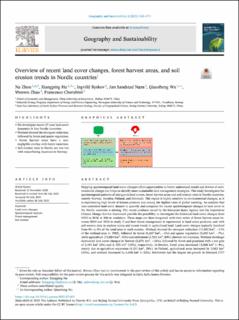| dc.description.abstract | Mapping spatiotemporal land cover changes offers opportunities to better understand trends and drivers of environmental change and helps to identify more sustainable land management strategies. This study investigates the spatiotemporal patterns of changes in land covers, forest harvest areas and soil erosion rates in Nordic countries, namely Norway, Sweden, Finland, and Denmark. This region is highly sensitive to environmental changes, as it is experiencing high levels of human pressure and among the highest rates of global warming. An analysis that uses consistent land cover dataset to quantify and compares the recent spatiotemporal changes in land cover in the Nordic countries is missing. The recent products issued by the European Space Agency and the Copernicus Climate Change Service framework provide the possibility to investigate the historical land cover changes from 1992 to 2018 at 300 m resolution. These maps are then integrated with time series of forest harvest areas between 2004 and 2018 to study if and how forest management is represented in land cover products, and with soil erosion data to explore status and recent trends in agricultural land. Land cover changes typically involved from 4% to 9% of the total area in each country. Wetland showed the strongest reduction (11,003 km2, −11% of the wetland area in 1992), followed by forest (8,607 km2, −1%) and sparse vegetation (5,695 km2, −7%), while agriculture (15,884 km2, 16%) and settlement (3,582 km2, 84%) showed net increases. Wetland shrinkage dominated land cover changes in Norway (5,870 km2, −18%), followed by forest and grassland with a net gain of 3,441 km2 (3%) and 3, 435 km2 (10%), respectively. In Sweden, forest areas decreased 13,008 km2 (−4%), mainly due to agriculture expansion (9,211 km2, 29%). In Finland, agricultural areas increased by 5,982 km2 (24%), and wetland decreased by 6,698 km2 (−22%). Settlement had the largest net growth in Denmark (717 km2, 70%), mainly from conversion of agriculture land. Soil erosion rates in Nordic countries are lower than the global average, but they are exacerbating in several locations (especially western Norway). The integration of the land cover datasets with maps of forest harvest areas shows that the majority of the losses in forest cover due to forestry operations are largely undetected, but a non-negligible share of the forest-to-agriculture (up to 19%) or forest-to-grassland (up to 51%) transitions overlap with the harvested sites. Forestry activity in the study region primarily involves small-scale harvest events that are difficult to be detected at the 300 m resolution of the land cover dataset. An accurate representation of forest management remains a challenge for global datasets of land cover time series, and more interdisciplinary international efforts are needed to address this gap. Overall, this analysis provides a detailed overview of recent changes in land cover and forest management in Nordic countries as represented by state-of-the-art global datasets, and offers insights to future studies aiming to improve these data or apply them in land surface models, climate models, landscape ecology, or other applications. | en_US |

